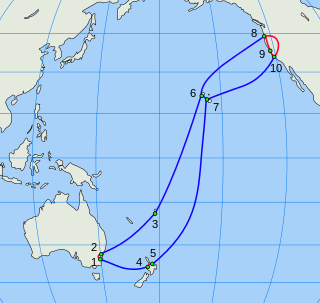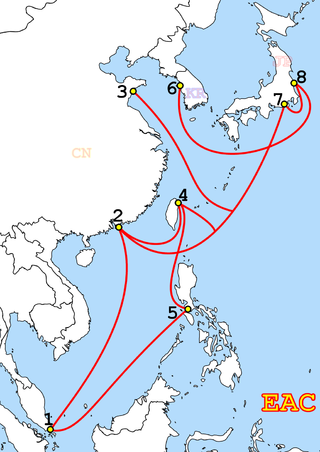
The Southern Cross Cable is a trans-Pacific network of telecommunications cables commissioned in 2000. The network is operated by the Bermuda-registered company Southern Cross Cables Limited. The network has 28,900 km (18,000 mi) of submarine and 1,600 km (990 mi) of terrestrial fiber optic cables, all which operate in a triple-ring configuration. Initially, each cable had a bandwidth capacity of 120 gigabit/s. Southern Cross offers capacity services from 100M/STM-1 to 100 Gbit/s OTU-4, including 1G, 10G and 40G Ethernet Private Line services.
Fibre-optic Link Around the Globe (FLAG) is a 28,000-kilometre-long fibre optic mostly-submarine communications cable that connects the United Kingdom, Japan, India, and many places in between. The cable is operated by Global Cloud Xchange, a subsidiary of RCOM. The system runs from the eastern coast of North America to Japan. Its Europe–Asia segment was the fourth longest cable in the world in 2008.

DisplayPort (DP) is a proprietary digital display interface developed by a consortium of PC and chip manufacturers and standardized by the Video Electronics Standards Association (VESA). It is primarily used to connect a video source to a display device such as a computer monitor. It can also carry audio, USB, and other forms of data.
APCN 2 or Asia-Pacific Cable Network 2 is a submarine telecommunications cable linking several countries in the Asia-Pacific region.

The Australia–Japan Cable, or AJC, is a 12,700 km submarine telecommunications cable system linking Australia and Japan via Guam that became operational in 2001. It had an original design capacity of 640 Gbit/s, but was initially equipped to use only 80 Gbit/s of this capacity. In April 2008 a capacity upgrade was completed, bringing equipped capacity to 240 Gbit/s. Design capacity was also increased to 1000 Gbit/s. Further upgrades will increase equipped capacity to meet increasing demand.

EAC-C2C is a submarine telecommunications cable system interconnecting several countries in Asia, the Pacific, and the United States. It is a merger of the former EAC and C2C cable systems. The merger occurred in 2007 by Asia Netcom, and the cable system is now owned/operated by Pacnet. Pacnet was acquired by the Australian telecommunications company Telstra in 2015.
Apollo is an optical submarine communications cable system crossing the Atlantic Ocean, owned by Apollo Submarine Cable System Ltd. It consists of 2 segments North and South, creating two fully diverse transatlantic paths.

Yellow / AC-2 is a submarine telecommunications cable system linking the United States and the United Kingdom. The cable is wholly owned by CenturyLink in the US following its acquisition of Global Crossing. The original owners, which each owned two of the fibre pairs, gave this cable system different names, so it is known as both Yellow and AC-2. It has a capacity of 320 Gbit/s as of January 2007, upgradeable to 640 Gbit/s.
TPC-5CN or Trans-Pacific Cable 5 Cable Network is a submarine telecommunications cable system linking Japan, Guam, Hawaii and mainland United States.

NPC is a submarine telecommunications cable system in the North Pacific Ocean linking the United States and Japan.
Japan-US is a submarine telecommunications cable system in the North Pacific Ocean linking the United States and Japan. It has landing points in:
G-P is a submarine telecommunications cable system in the North Pacific Ocean linking the two named territories.

CUCN or China-US Cable Network was a submarine telecommunications cable linking several countries in the Asia-Pacific region. It was retired from service in December 2016.
TGN-Pacific is a submarine telecommunications cable system transiting the Pacific Ocean.
PacRimWest was a twin-pair 560 Mbit/s optical submarine telecommunications cable which served as Australia's main link to the world along with its partner cables Tasman2 and PacRimEast.
Unity is a Trans-Pacific submarine communications cable between Japan and the United States that was completed in April 2010.

TPE or Trans-Pacific Express is a submarine telecommunications cable linking China, South Korea, Taiwan, Japan, and the United States. The line is a US$500 million joint venture between 6 telecommunication companies China Telecom, China Netcom, China Unicom, Chunghwa Telecom, Korea Telecom, and Verizon Communications. Ownership of the cable is evenly split between the 6 participants. Construction of this 11,000 miles line was completed in September 2008, and the Japan branch was completed in January 2010.
TRANSPAC or Trans-pacific cable (TPC) is a series of undersea cables under the Pacific Ocean.
Thunderbolt is the brand name of a hardware interface for the connection of external peripherals to a computer. It was developed by Intel in collaboration with Apple. It was initially marketed under the name Light Peak, and first sold as part of an end-user product on 24 February 2011.








